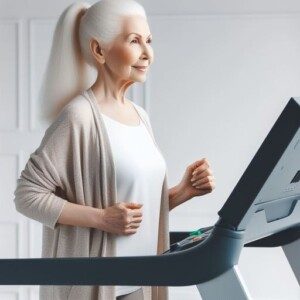
Elderly people are notorious for walking very slowly, but this doesn’t mean it has to be so.
Slow walking does NOT have to be a non-preventable effect of old age. Furthermore, the ability to RUN need not disappear in senior age.
Why do old people walk so slowly?
Common sense would cite a loss of strength due to loss of muscle mass in the legs. A recent issue of The Journal of Physiology confirms this.
The obvious solution is to do exercises that build muscle mass in the legs. Strength training also builds bone mass.
But why wait till so much muscle has been lost that walking becomes snail-like?
Building up as much muscle as possible during one’s younger years, via strength training, would create a reserve of muscle as well as bone mass.
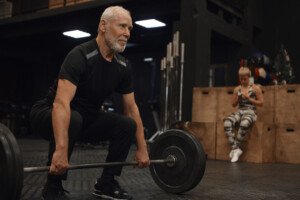
The deadlift exercise works the entire body in addition to the legs and hips. Shutterstock/Anatoliy Karlyuk
Think of building muscle mass like a savings account. The more money you have in it come retirement age, the more you can withdraw from it yet still have some good reserve left.
But what keeps people in their younger age (and this includes middle age) from building muscle in their legs?
According to the Physiology journal, three components of ambulation are at play that influence walking speed:
• Joint flexibility
• Walking mechanics
• Leg muscles
The paper says that building the leg muscles by far beats out the other two influencers for prevention of elderly paced walking.
Why More People Don’t Build Leg Muscle
I’ve always known (human intuition? Vulcan logic?) that doing weightlifting exercises with my legs would prevent “old person walking.”
A common reason women don’t want to do leg presses, barbell squats and leg extensions is because they think they’ll bulk up.
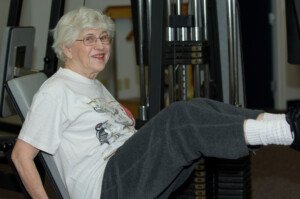
Shutterstock/Wendy M. Simmons
But most MEN in the general population don’t lift weights, either.
What keeps the average Joe and Jane from stepping into a gym, loading a barbell and then squatting?
Or how about walking-lunges while holding dumbbells? What about hamstring curls? What about jump squats?
Is it really lack of time? Funny, sedentary people always manage to find time to watch a lot of TV and sit for long periods before a computer at home.
Most people simply do not want to work out. Period. And many who do don’t work out hard enough to make a dramatic difference in the way their body ages.
Guide to Preventing Slow Walking Typical of the Elderly
• Build leg muscle.
• You can build a lot of muscle WITHOUT bulking up.
• Building leg muscle will not make your legs stiff or slow down your stride.
• Do the squat (many varieties), leg press, leg extension, leg curl, lunge and jumping exercises such as pike jumps and box jumps.
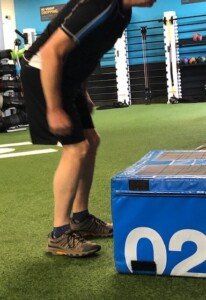
If you’re of senior age, get medical clearance from your physician before doing any kind of platform jumping, as this older man was doing.
• Do parking lot dashes, hill dashes and staircase dashes alternating with a few minutes of easy recovery movement. If you can’t sprint or dash, then trot or just walk as fast as you can.
What if you’re already old and slow?
It’s never too late to start lifting weights. If your best squat is shallow and all you can hold is an eight-pound medicine ball, then do that.
You can also do chair squats. Simply sit in a sturdy chair (not a sofa-type) in which your knees are slightly lower than hip level.
Now stand up, trying not to let the back of your lower legs lean into the chair.
Repeat up to 12 times in a row.
In addition, get a gym membership and start using the leg equipment.
Buy small dumbbells and walk around the house holding them with straight arms.
Walk as fast as possible whenever you have to walk from point A to point B.
If you use a treadmill, DO NOT HOLD ON!
“Never hold onto the hand rails because they act like a crutch, preventing recruitment of balancing muscles, transferring the load from the legs to the upper body, and creating an unnatural walking pace which may result in muscle strains,” explains Dr. Tom Carpenter, a corrective exercise specialist, certified personal trainer and chiropractor.
If you feel too old and slow to speed up your walking, do interval training: Alternate your fastest speed (for 30 seconds) with a leisurely pace (for several minutes) over a half hour.
We all get old and slow down. We can’t live forever.
But building muscle in the legs before your walking becomes slowed down from old age will make a significant difference in your walking speed when you do reach old age.
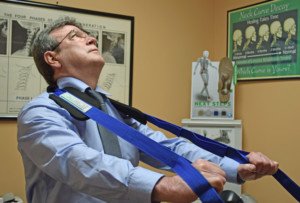
Photo credit: Aleesia Forni
Based upon 30+ years of experience, Dr. Carpenter’s practice approach reflects his belief that restoring optimum health and function will enable his patients to enjoy a much greater amount of vitality and wellness. Chiropractic care is true health care, not sick care!
 Lorra Garrick has been covering medical, fitness and cybersecurity topics for many years, having written thousands of articles for print magazines and websites, including as a ghostwriter. She’s also a former ACE-certified personal trainer.
Lorra Garrick has been covering medical, fitness and cybersecurity topics for many years, having written thousands of articles for print magazines and websites, including as a ghostwriter. She’s also a former ACE-certified personal trainer.
.









































